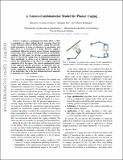Notice
This is not the latest version of this item. The latest version can be found at:https://dspace.mit.edu/handle/1721.1/139433.2
A Convex-Combinatorial Model for Planar Caging
Author(s)
Aceituno-Cabezas, Bernardo; Dai, Hongkai; Rodriguez, Alberto
DownloadSubmitted version (1.162Mb)
Open Access Policy
Open Access Policy
Creative Commons Attribution-Noncommercial-Share Alike
Terms of use
Metadata
Show full item recordAbstract
Caging is a promising tool which allows a robot to manipulate an object without directly reasoning about the contact dynamics involved. Furthermore, caging also provides useful guarantees in terms of robustness to uncertainty, and often serves as a way-point to a grasp. However, caging is traditionally difficult to integrate as part of larger manipulation frameworks, where caging is not the goal but an intermediate condition. In this paper, we develop a convex-combinatorial model to characterize caging from an optimization perspective. More specifically, we derive a set of sufficient constraints to enclose the configuration of the object in a compact-connected component of its free-space. The convex-combinatorial nature of this approach provides guarantees on optimality and convergence, and its optimization nature makes it versatile for further applications on robot manipulation tasks. To the best of our knowledge, this is the first optimization-based approach to formulate the caging condition.
Date issued
2019Journal
2019 IEEE/RSJ International Conference on Intelligent Robots and Systems (IROS)
Publisher
Institute of Electrical and Electronics Engineers (IEEE)
Citation
Aceituno-Cabezas, Bernardo, Dai, Hongkai and Rodriguez, Alberto. 2019. "A Convex-Combinatorial Model for Planar Caging." 2019 IEEE/RSJ International Conference on Intelligent Robots and Systems (IROS).
Version: Original manuscript